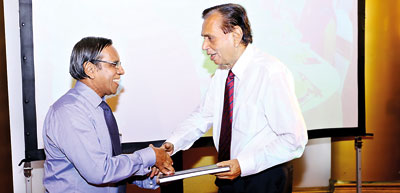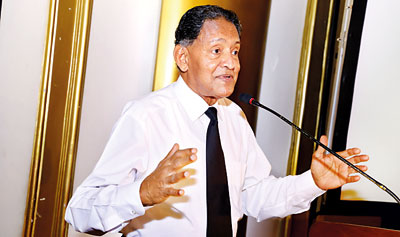The Colombo Club inks its glorious past

The author (right) hands over the book to Colombo Club chairman and (below) Guest speaker President’s Counsul Kanaganayagam Kanag-Isvaran
It was in 1871, at a time when the environs of Galle Face were that much more expansive and played host to ubiquitous society events that had the British enjoy the then Ceylon’s balmy weather in their large numbers, that the statuesque edifice with its ‘nightcap’ architecture saw the birth of The Colombo Club. The structure, which was leased from the Assembly Rooms Company Limited for Sterling Pounds 150 annually had the backing of Governor Sir Hercules Robinson, who was also the Chairman of the Turf Club.
The Club has since moved its ‘Club House’ from the Grand Oriental Hotel to Ceylinco House, Hotel Taprobane, Galadari, Hilton International and Hotel Lanka Oberoi before finally settling down at the then Taj Lanka (Taj Samudra), closer to its original birthplace. It was indeed fitting that the gala luncheon held for the launch of ‘The History of The Colombo Club’ in September was indeed held on the very same founding ground as in 1871, at the old Club building of the Samudra ballroom.
Embellished with photographs and sketches most by unidentified artists and photographers of the time, the book is a factual account of the Club’s history through the decades, augmented by additional information about the history of clubs in Ceylon. The idea of a club was mooted by the first Governor of Ceylon, Frederick North, who addressed Colonial Secretary Lord Hobart in 1804 on ‘social aspects’ that need to be focused on. However, it was Sir Hercules Robinson who was the actual initiator of the Club and responsible for the land being made available for the Club. He was elected its founding President.
The book is penned by well known author Franklyn G. Amerasinghe, who for his commitment to painstakingly researching the legacy of this colonial club was accorded an Honorary Membership of the Club. He posits that at the time, the Empire had a virtual template for its behaviour in the colonies. “These colonial clubs anywhere in the world had similarities in terms of service,” he said, relating how for example, when a guest requested papaya in Malaysia, he was told that native fruits are not served but he could have dried apricots instead. “Very simply, the need to encourage British entrepreneurs to invest and settle in the Colonies was as important as it was to select loyal and reliable officers to administer and manage the affairs in these outposts.” Hence the birth of the Cocoa-nut Club or Whist Club and the Quoit Club to name just two.

Amerasinghe detailed that in conducting research for this book, there were many sources he banked on. He appreciated the instructive article written by Professor K.D. Paranavitane which helped some of his archival research, as did the efforts of Dr. Rajpal De Silva, who gave Amerasinghe full access to his library and permitted the use of a valuable book, ‘19th Century Engravings; Newspaper Readings of Ceylon’, a much quoted text. Amerasinghe’s research also extended to using information from ‘Twentieth Century Impressions of Ceylon’ by Arnold Wright who regarded The Colombo Club as ‘the premier club in Ceylon’ and material from the book on the Supreme Court by Dr. Ranjit Amerasinghe and H.A. J. Hulugalle’s book on the British Governors of Ceylon.
Extremely well researched was the humorous yet fact-filled address on ‘The Phenomenon of the Gentlemen’s Club’ made by erudite Guest Speaker, President’s Counsel Kanaganayagam Kanag-Isvaran. Walking down memory lane, his remarks about the typical milieu existent in British clubs in those days brought about much humour. “The term ‘club’ appears not to have been used until 1659 and is typically an English institution. It was at the end of the 16th century that these were established. There’s the Friday Street Club that met at the Mermaid Tavern in London for example whose membership included John Donne, John Selden, Francis Beaumont and John Fletcher and it’s often asserted that William Shakespeare and Walter Raleigh were members. Shortly after, the word club was used in relation to a political club, called the Rota, resulting in the inclusion of politics into club life,” Mr. Kanag-Isvaran said.
He mentioned that historians write that the word ‘Clubbe’ was used for solidarity and that Pall Mall was noted for its tavern clubs for more than two centuries becoming an inhabited locality of one of the earliest uses of the word, ‘clubbing’.
“Through trials and tribulations whether the great plague or the great fire, clubs were formed for various reasons, ranging from the Men of the Rose Tavern in Covent Gardens (aka the Treason Club) and the Wednesday Club which led to the creation of the Bank of England, with Samuel Johnson describing the club, ‘As an assembly of good fellas meeting under certain conditions’.” So it was that clubs were genuinely formed to provide good fellowship with social intercourse becoming common, with men finding themselves agreeing on issues and discussion, establishing a fraternity.
He also noted that Picadilly Circus, St. James’ Street and St. James’ Square were fashionable locations that saw the establishment of many a tavern and coffee house with Mrs White’s Chocolate House, a hot chocolate emporium established in 1693 yet in its original location. Mr. Kanag-Isvaran explained that rooms were reserved for its more exclusive clientele as aristocrats didn’t want to mix with others especially for gambling which was an addiction in the 18th century. White’s is today a Gentlemen’s Club on Prince Street, with current members including Prince Charles, Prince William and formerly David Cameron, who resigned due to the Club’s refusal to admit a woman!
Clubs became a permanent institution where members absorbed the whole accommodation for meetings with the peripatetic lifestyles of the colonial expansion leading to the middle class driving the development of these clubs with bedrooms and other facilities. “Clubbing with like-minded members was convenient. It was a means for those living abroad to rejoin society when they returned and like in the plantations here, it was easier to meet your old friends in the oriental situation. Club membership proved a readymade means of social intercourse, information network and social status. The prestige and recognition made you more of a gentleman.”
Kanag-Isvaran, on a lighter note observed however that the crucial part of the traditional club and its ethos was in providing peace and quiet, which was afforded exclusively by male companionship. “Which means, no women! These hardcore clubmen defined the all-male policy with no embarrassment. If at any time ladies were allowed to penetrate the club’s defences, it was through a side entrance.” He concluded that for many men, the club was their true home. They were relaxed, found connection, comfort and entertainment.
For The Colombo Club however, the journey has been different. The original resolution states, “That a club be formed for the purpose of establishing and maintaining reading, billiard, card and refreshment rooms in Colombo for the benefit of the members and generally for the carrying out of all purposes incidental to social clubs of the above description. And that the Club be called The Colombo Club.”
The Club’s history supports the idea that ladies were admitted for activities but was steadfast in its determination to maintain it as a place where men were free to do their own thing and not be contained by the presence of ladies, even in indulging in excessively high spirits. With this in mind, in 1944, members were allowed to invite lady guests to watch charity sports functions on Galle Face and by 1947, come in as guests any day of the week. But it was only in 1995 that Chloe De Soysa was admitted into the membership, the first woman to penetrate this male bastion with more women following suit, later.
Amerasinghe deduces in closing, “From that attitude of being a British Club, changes in the country dictated that if the Club was to survive it needed a sea change and a paradigm shift……The change in the Club may have come with a realization that what the Club really wanted to do was to provide an exclusive meeting place for like-minded people.”


